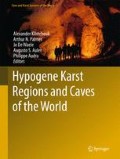Abstract
This chapter describes the Ordinskaya Cave in the Fore-Urals region, Russia, which is the largest underwater cave of sulfate rocks in the world. The explored length of the cave is about 4900 m. The regional distribution of karst features indicated that a large amount of recharge entered the lower passages during all stages of development. The groundwater in the cave is aggressive with respect to sulfate. Discharge of water with higher mineralization was documented during the spring floods. During summer low-flow periods, subaqueous springs discharge waters under artesian conditions with a lower solute content. In the cave, the degree of saturation of water increases from the bottom to the top in the spring season and is the reverse in the summer. Seasonal variations in the groundwater chemical composition reflect the contribution from the artesian system. The geological data indicate a strong relationship between the karst features and the regional fault network. The characteristic features of the Ordinskaya Cave make it a model object of artesian hypogene speleogenesis.
Access this chapter
Tax calculation will be finalised at checkout
Purchases are for personal use only
References
Chaykovskiy II, Kadebskaya OI (2009) The role of tectonics in formation of mineralization and karst of the Kazakovskaya Gora. In: Proceedings of the conference Geologiya i poleznye iskopaemye Zapadnogo Urala, Perm State University, Perm, pp 18–24 (in Russian)
Dublyanskiy VN (ed) (2005) Kungur ice cave: results of the regime observation. UB RAS, Yekaterinburg (in Russian)
Ford D, Williams PD (2007) Karst hydrogeology and geomorphology. Wiley
Gorbunova KA, Andreychuk VN et al (1992) Karst and caves of the Perm region. Perm State University, Perm (in Russian)
Kadebskaya OI, Maksimovich NG (2009) Geological, hydrogeological and hydrogeochemical pre-requisites of the Ordinskaya Cave formation. In: Peshchery, v 32. Perm State University, Perm, pp 11–22 (in Russian)
Kadebskaya OI, Maksimovich NG, Zhakova UV (2009) Karst features at the area of Ordinskaya Cave (Perm krai, Russia). Speleologiya i karstologiya 3:60–65 (in Russian)
Klimchouk AB (1996) The typology of gypsum karst according to its geological and geomorphological evolution. In: Klimchouk AB, Lowe D et al (eds) Gypsum Karst of the World. Int J Speleol, Theme issue 25(3–4):49–60
Klimchouk AB (2007) Hypogene speleogenesis: hydrogeological and morphogenetic perspective. Special paper no. 1, National Cave and Karst Research Institute, Carlsbad, NM
Klimchouk A (2009) Morphogenesis of hypogenic caves. Geomorphology 106(1):100–117
Klimchouk AB (2016) Types of hypogene speleogenesis. In: Chavez T, Reehling P (eds) Proceedings of deep karst: origins, resources, and management of hypogene karst, NCKRI symposium 6, National Cave and Karst Research Institute, Carlsbad, New Mexico
Lavrov I, Maximovich E, Maximovich N (2005) Ordinskaya cave—the longest underwater cave in Russia. In: Proceedings of conference water resources and environmental problems in karst, Serbia, Montenegro, 13–19 Sept 2005, Belgrade, pp 771–776
Maksimovich GA (1969) Caves of gypsum karst. In: Peshchery. v 8. Perm State University, Perm, pp 5–29 (in Russian)
Maksimovich NG, Maksimovich EG, Lavrov IA (2006) Ordinskaya Cave. The longest underwater cave of Russia. Knizhnyy mir, Perm (in Russian)
Mikhaylov GK, Oborin AA (2006) Underground fresh waters resources of Sylvenskiy ridge. UB RAS, PSU, Perm (in Russian)
Sivinskih P (2009) Features of geological conditions of the Ordinskaya underwater cave, fore-Urals, Russia. In: Klimchouk AB, Ford DC (eds) Hypogene speleogenesis and karst hydrogeology of Artesian basins. Special Paper, Ukrainian Institute of Speleology and Karstology, Kiev, vol 1, pp 267–271
Author information
Authors and Affiliations
Corresponding author
Editor information
Editors and Affiliations
Rights and permissions
Copyright information
© 2017 Springer International Publishing AG
About this chapter
Cite this chapter
Kadebskaya, O.I., Maksimovich, N.G. (2017). The Role of Hypogene Speleogenesis in the Formation of the Ordinskaya Cave, Fore-Urals, Russia. In: Klimchouk, A., N. Palmer, A., De Waele, J., S. Auler, A., Audra, P. (eds) Hypogene Karst Regions and Caves of the World. Cave and Karst Systems of the World. Springer, Cham. https://doi.org/10.1007/978-3-319-53348-3_26
Download citation
DOI: https://doi.org/10.1007/978-3-319-53348-3_26
Published:
Publisher Name: Springer, Cham
Print ISBN: 978-3-319-53347-6
Online ISBN: 978-3-319-53348-3
eBook Packages: Earth and Environmental ScienceEarth and Environmental Science (R0)

